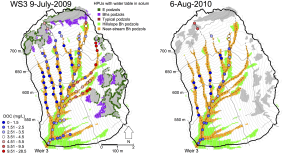 JP Gannon just had another paper accepted in Water Resources Research this week. The study suggests that dissolved organic carbon (DOC) in headwater streams may be generated from shallow to bedrock regions in the catchment, which mostly occur near the catchment divides and channel heads. The study also suggests that hydropedological patterns are critical to understanding DOC sources to streams.
JP Gannon just had another paper accepted in Water Resources Research this week. The study suggests that dissolved organic carbon (DOC) in headwater streams may be generated from shallow to bedrock regions in the catchment, which mostly occur near the catchment divides and channel heads. The study also suggests that hydropedological patterns are critical to understanding DOC sources to streams.
Abstract: We investigated potential source areas of dissolved organic carbon (DOC) in headwater streams by examining DOC concentrations in lysimeter, shallow well, and streamwater samples from a reference catchment at the Hubbard Brook Experimental Forest. These observations were then compared to high frequency temporal variations in fluorescent dissolved organic matter (FDOM) at the catchment outlet and the predicted spatial extent of shallow groundwater in soils throughout the catchment. While near-stream soils are generally considered a DOC source in forested catchments, DOC concentrations in near-stream groundwater were low (mean = 2.4 mg/L, standard error = 0.6 mg/L), less than hillslope groundwater farther from the channel (mean = 5.7 mg/L, standard error = 0.4 mg/L). Furthermore, water tables in near-stream soils did not rise into the carbon rich upper B or O horizons even during events. In contrast, soils below bedrock outcrops near channel heads where lateral soil formation processes dominate had much higher DOC concentrations. Soils immediately downslope of bedrock areas had thick eluvial horizons indicative of leaching of organic materials, Fe, and Al and had similarly high DOC concentrations in groundwater (mean = 14.5 mg/L, standard error = 0.8 mg/L). Flow from bedrock outcrops partially covered by organic soil horizons produced the highest groundwater DOC concentrations (mean = 20.0 mg/L, standard error = 4.6 mg/L) measured in the catchment. Correspondingly, streamwater in channel heads sourced in part by shallow soils and bedrock outcrops had the highest stream DOC concentrations measured in the catchment. Variation in FDOM concentrations at the catchment outlet followed water table fluctuations in shallow to bedrock soils near channel heads. We show that shallow hillslope soils receiving runoff from organic matter-covered bedrock outcrops may be a major source of DOC in headwater catchments in forested mountainous regions where catchments have exposed or shallow bedrock near channel heads.